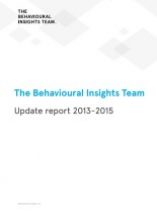The Update Report covers the past two years of the Behavioural Insights Team’s work.
The report contains many new results, including:
- Raising the pass rate for ethnic minority applicants to the police on a key exam from 40 to 60 percent, closing the gap with white applicants entirely, by prompting applicants to think about why the job was important to ‘you and your community’.
- Reducing the drop-out rate from Further Education course by a third, by sending encouraging texts such as at the end of half-term breaks.
- Doubling the completed application rates to join the Army Reserve by sending an email from a serving officer talking about their experiences.
- Increasing the payment rates by the top 1 percent of tax-debtors by 43 percent without further prompts, by highlighting the impact on public services of non-payment.
It’s been an exciting period for the team. We’ve managed to expand the breadth and scale of our work (having now run more than 100 trials across almost every area of policy). But the core of what we do remains the same as when we started life in No10 5 years ago: making public services more cost-effective and easier for citizens to use; improving outcomes by introducing a more realistic model of human behaviour to policy; and wherever possible, enabling people to make ‘better choices for themselves’.
Collectively, the findings from this report show that:
- Behavioural Insights approaches are delivering successful results across an ever wider range of policy areas.
- Government departments in the UK are strengthening their internal behavioural capabilities (and most of the examples in this report are collaborations between BIT and these teams.
- Governments across the world – at local and national level – are starting to adopt the approaches.
- The use of more experiments and trials, as championed by BIT, is spreading into other areas of Government and practice.
- An important corollary of this experimental approach is that it also identifies things that do not work – and we have included examples in the report.
- Identifying what works, when and for whom is a key frontier.



